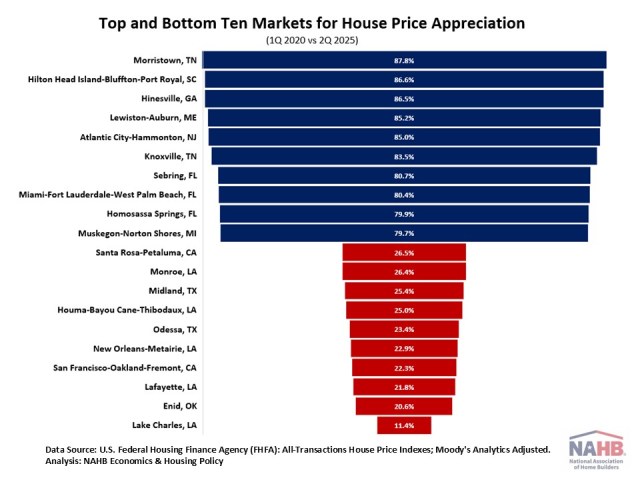House Price Appreciation by State and Metro Area: Second Quarter 2025
Jing Fu
September 3, 2025
FHFA HPI,Home Sales and Prices,house price appreciation,house prices,local data,metro data,state data
House price growth continued to slow in the second quarter of 2025, as the housing market faces mounting pressure from high mortgage rates, elevated inventory, and persistent economic uncertainty. After years of rapid growth, the District of Columbia and 27 metro areas recorded modest house price declines during this quarter, highlighting the regional variations in market performance.
Nationally, according to the quarterly all-transactions House Price Index (HPI) released by the Federal Housing Finance Agency (FHFA), U.S. house prices rose 3.8% in the second quarter of 2025, compared to the second quarter of 2024. This marks the slowest year-over-year increase since 2013, indicating the broader market cooldown following a decade of robust gains.
The FHFA’s all-transactions HPI tracks average price changes based on repeat sales and refinancings of the same single-family properties. It offers insights not only at the national level but also across states and metropolitan areas.
Between the second quarter of 2024 and the second quarter of 2025, all 50 states experienced positive year-over-year (YoY) house price appreciation, ranging from 0.9% to 7.5%. In contrast, the District of Columbia saw a 3.4% decline in house prices. Connecticut and New York led the nation with a 7.5% gain each, followed by Rhode Island with a 6.9% gain. On the opposite end, Colorado recorded the lowest house price appreciation at 0.9%. Out of all 50 states and the District of Columbia, 30 states exceeded the national YoY growth rate of 3.8%. However, on a quarterly basis, home price appreciation decelerated in 44 states and the District of Columbia compared to the first quarter of 2025, highlighting a broad-based deceleration in the housing market.
House price growth widely varied across U.S. metro areas year-over-year, ranging from -7.4% to +18.1%. Punta Gorda, FL recorded the largest decline in house prices, whereas Sumter, SC posted the highest increase over the previous four quarters. In the second quarter of 2025, 27 metro areas, in reddish color on the map above, experienced negative house price growth. Meanwhile, 359 metro areas experienced price increases.
Since the onset of the COVID-19 pandemic, house prices have surged nationally. Between the first quarter of 2020 and the second quarter of 2025, house prices rose by 54.6% nationwide. More than half of metro areas outpaced this national price growth rate of 54.6%.
The table below highlights the top ten and bottom ten markets for house price appreciation during this five-year period. Among all the metro areas, house price appreciation ranged from 11.4% to 87.8%. Morristown, TN led the nation with the highest house price appreciation. Lake Charles, LA recorded the lowest appreciation, marking its fifth consecutive quarter at the bottom.

Discover more from Eye On Housing
Subscribe to get the latest posts sent to your email.





